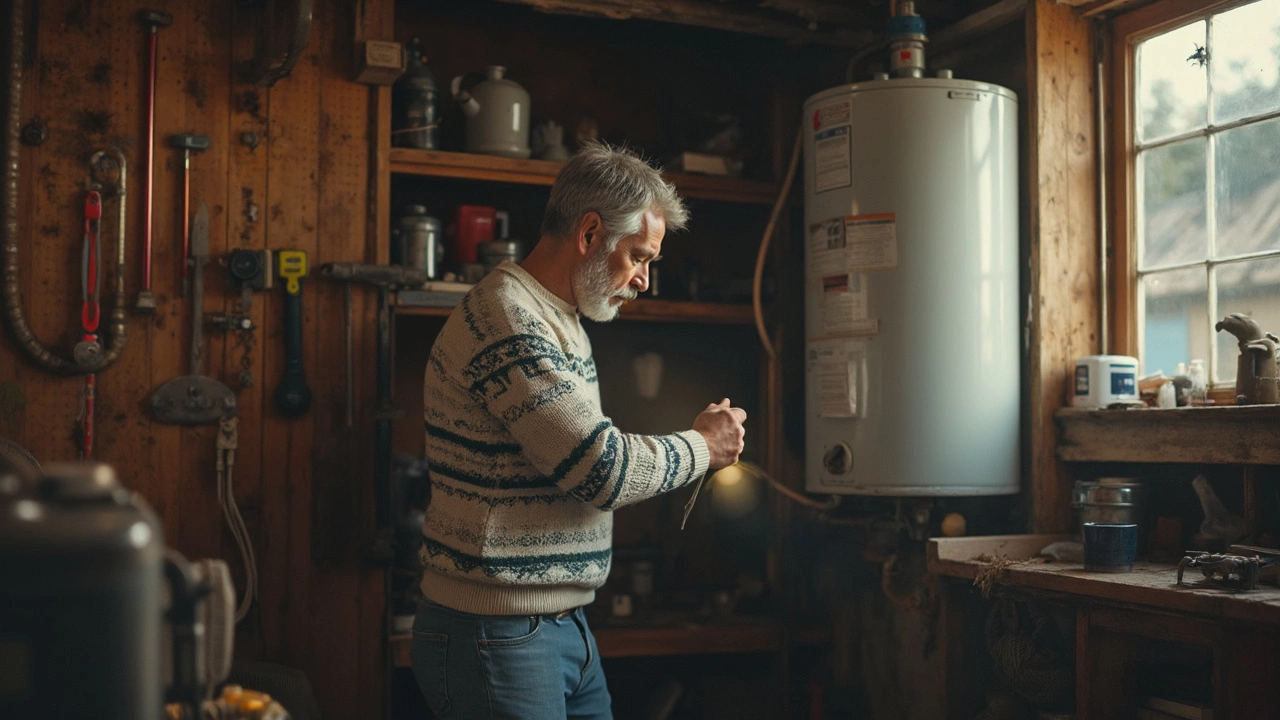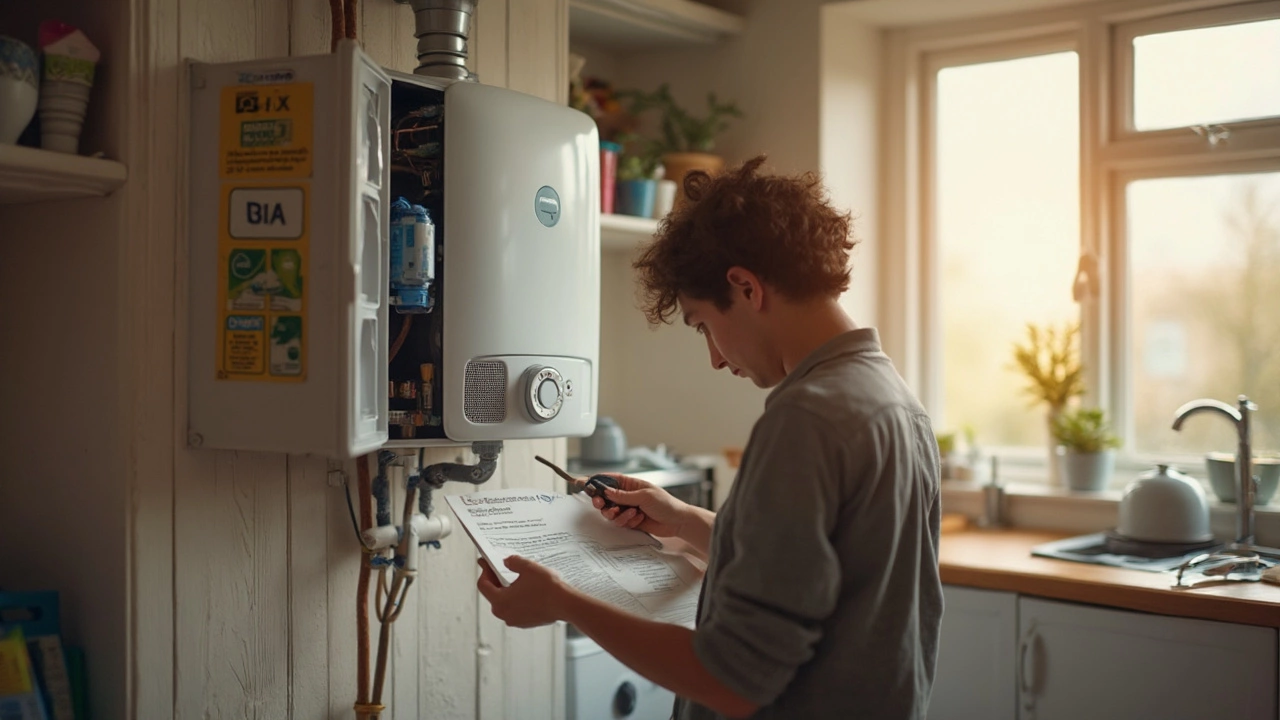So, your hot water heater isn’t doing its job, and now you're considering giving it a reset? Good move. A simple reset can often solve minor issues and get that warm water flowing again. But before you dive right in, here's what you need to know.
Understanding your water heater is the first step. Generally, there are two types: electric and gas. They look and function differently, so recognizing which one you have can save a lot of head-scratching later. If you have an electric heater, a tripped reset button is a common culprit. Gas heaters, on the other hand, might need attention to their pilot light. Each has its own reset process, and we'll walk you through both.
Safety comes first. Make sure to turn off the power supply to the heater and secure the area before any fiddling begins. With the right precautions, resetting doesn't have to be intimidating. Let's get that hot water back to where it belongs—your shower.
- Understanding Types of Water Heaters
- Safety First: Precautions to Take
- Steps to Reset an Electric Water Heater
- How to Reset a Gas Water Heater
- Common Issues and Solutions
- Maintenance Tips for Longevity
Understanding Types of Water Heaters
Okay, before you get your hands dirty, let's talk about the two main types of hot water heaters you’re likely to encounter: electric and gas. Each has its own quirks and features, so it's handy to know what you're dealing with.
Electric Water Heaters
Electric water heaters are pretty common in homes where gas isn’t an option. They function by using electricity to heat up coils inside the tank, which then warms the water. They're generally easy to install and maintain. A cool thing about electric water heaters is their efficiency—no venting is required, which is a win if your space is limited. A downside, though, is that they can be a bit slower in heating water compared to gas heaters.
Keep an eye out for their reset button, often red and located on or around the thermostat. If your heater isn't working, a simple button press might do the trick.
Gas Water Heaters
Now, if you’ve got a gas water heater, it’s a different ball game. Instead of electric coils, these use a burner located at the bottom of the tank. They’re generally faster when it comes to delivering hot water and can be quite economical, depending on local gas prices. However, installation and ventilation can get a bit complicated.
One of the key things here is the pilot light—if it’s out, you’ll want to relight it to get back in action. Usually, there's a clear instruction sticker on the heater itself for lighting the pilot.
For both types, household size and usage can dictate the capacity you need. Generally, a 40-gallon tank is great for a couple while families might want to explore larger options. Check this out:
| Household Size | Recommended Capacity |
|---|---|
| 1-2 people | 30-40 gallons |
| 3-4 people | 40-50 gallons |
| 5+ people | 50+ gallons |
So, identify which type you have before proceeding with your water heater repair. It’s the first step to ensuring you follow the right method for your reset job.
Safety First: Precautions to Take
Before you roll up your sleeves to reset your hot water heater, safety should be your #1 concern. Here’s how you keep things safe and sound.
Shut Off the Power
This might sound like the most basic thing, but trust me, it's crucial. If you're working with an electric heater, flip the switch at the circuit breaker. For gas heaters, turn the gas valve to the 'off' position. No one wants a zap from a misstep or a whiff of gas.
"Safety is a cheap and effective insurance policy." - Author Unknown
Tools You Might Need
You don't need to be a professional plumber, but some tools will make your life a lot easier. Keep a multimeter handy if you have an electric heater; it helps you check if the power is really off. A wrench could be useful too, even if it’s just to tighten any loose bolts.
- Non-contact voltage tester (for electric heaters)
- Adjustable wrench
- Protective gloves
- Flashlight (for dimly-lit areas)
Be Aware of Hot Surfaces
Watch out for steam or hot water when accessing the tank. Gloves are not just for warmth; they're your shield.
Safety Gear
A good pair of safety goggles and gloves can prevent unwanted mishaps. If you’re working in a garage or utility room, adequate lighting will go a long way in preventing accidents.
If you follow these precautions, you'll be tackling your water heater troubleshooting like a pro, safe in the knowledge that you're doing everything to prevent an avoidable accident. Play it smart and be prepared.
Steps to Reset an Electric Water Heater
Resetting an electric water heater isn’t rocket science, but it can certainly feel like it if you’re not sure where to start. Most problems are related to a tripped thermostat, and a reset often does the trick. Here’s a straightforward step-by-step guide to resetting your electric water heater.
Turn Off the Power
Safety first! Head to your breaker box and flip the switch for your water heater to ‘off.’ This prevents any electrical accidents while you’re poking around inside.
Access the Reset Button
The reset button, also known as the high-limit reset button, is usually located behind a metal panel on your water heater. Grab a screwdriver—preferably one that matches the screws holding the panel—and remove the screws to gain access.
Press the Reset Button
Now, you should see a series of thermostats and wires. Look for the red button, which could sometimes be labeled ‘RESET’ or ‘RESET BUTTON.’ Go ahead and press it. You should feel a slight click. If the button won't stay in, it might indicate a bigger issue with the thermostat or wiring.
Reassemble Everything
Replace the metal panel and securely fasten the screws. Make sure everything is snug as a bug, just in case you need to troubleshoot more issues later—you wouldn't want anything loose.
Turn the Power Back On
Head back to the breaker box and flip the switch for your water heater to ‘on.’ Give it a good half-hour or so to heat up and see if hot water returns.
Check for Success
If you hear the gentle hum of the heating elements at work, you probably nailed it. Test your taps to see if hot water flow resumes. However, if it trips again or there's still no hot water, you might be dealing with a bigger issue, like a faulty element or wiring that needs professional attention.
Looking out for these potential issues can keep your water heater functioning well. Regular checks and a simple reset can save you a lot of time and even extend the life of your heater.

How to Reset a Gas Water Heater
Dealing with a gas water heater that's acting up? No worries. Resetting it can often bring things back to normal. Let's walk through the process together so you can enjoy hot showers again.
Step One: Safety Check
Before anything else, turn off the gas supply. Locate the gas shut-off valve, which is usually near the heater, and make sure it's turned off. This is essential for your safety and prevents any mishaps.
Step Two: Pilot Light Inspection
Gas heaters rely on a pilot light to ignite the burner and heat water. If you're not getting hot water, a common issue is an extinguished pilot light. You'll want to check whether it's still lit. If not, it's time to relight it.
Step Three: Relight the Pilot Light
- Turn the gas control knob to the 'off' position and wait five minutes for any gas to clear.
- Once cleared, turn the knob to 'pilot', press it down, and hold while lighting the pilot with a long lighter.
- Continue to hold the knob down for about 30 seconds to make sure the pilot stays lit.
- Release the knob and turn it from 'pilot' to 'on'.
Voila, your pilot light is back on, and with it, hopefully, your hot water heater!
Step Four: Reset the Thermostat
Sometimes, a hard reset of the thermostat is needed. This means you'd locate the power button or the reset button (often a red button) on the heater's thermostat. Hold it down until you hear a click.
Step Five: Restart Gas Supply
Now, safely turn the gas supply back on using the shut-off valve, and allow your heater to work its magic. After a few minutes, try checking if the water is heating up as expected.
If this doesn't solve the issue, there might be a need for professional intervention. But hey, at least you tried the essentials, and it's often something simple.
Keeping these steps in mind can help in a pinch. Remember, regular maintenance is key to avoiding these hiccups in the first place. It's also wise to trace your heater's usage pattern. Quick tip: Set your thermostat to around 120 degrees Fahrenheit—it’s efficient and prevents scalding!
Common Issues and Solutions
Having trouble with your hot water heater? It’s a common issue that many homeowners face, but the good news is, most of the time, the fix is easier than you think. Here are some typical problems and straightforward solutions.
No Hot Water
This is probably the most frustrating problem. If you have an electric water heater, the reset button might have tripped. First, locate your heater’s power panel, look for a red button, and give it a press. Still cold? Check your circuit breaker. It might have flipped off, cutting power to the heater.
For gas heaters, ensuring that the pilot light is on is crucial. If it's out, follow the manufacturer’s guide to relight it. Remember, no flame might mean no hot water.
Strange Noises
Hearing popping or banging from your heater? That’s usually a sign of sediment buildup. Over time, minerals in the water settle at the bottom of the tank and harden. This can reduce efficiency and cause those annoying sounds.
Draining the tank to clear out sediment is your solution here. Make sure to turn off the heater and let the water cool. Then, attach a hose to the tank’s drain valve, let the water out, and flush until it runs clear.
Leaking Water
Leaky tanks can be a real headache. If you notice water pooling around your heater, first ensure it's not condensation or overflow from the pressure relief valve, which might just need tightening. For persistent leaks, it’s often best to call a professional, as it could mean tank damage.
Fluctuating Water Temperature
Nobody likes a surprise cold shower. If your water isn’t maintaining a consistent temperature, it might be a faulty thermostat for electric heaters. Check the settings, ensure it’s tightly secured, and replace it if necessary.
For gas units, the pilot or burner might not be functioning correctly. Cleaning the burner or adjusting the thermocouple could restore stable heating.
Water Smells or Discolors
Smelly or discolored water tends to be a bacterial issue. Running a deep clean on the tank involves turning it off, draining the water, and then refilling and sanitizing it. A mix of hydrogen peroxide and water usually does the trick here.
Regular maintenance plays a huge role in preventing these issues. Annual inspections and periodic flushing can extend the life of your water heater and keep it running smoothly.
Maintenance Tips for Longevity
Keeping your hot water heater in tip-top shape isn't just about quick fixes; it's about regular maintenance to keep those hot showers coming. A bit of effort can extend the lifespan of your trusty appliance and keep headaches at bay.
Flush the Tank
First up, let’s talk about flushing the tank. Sediment builds up at the bottom over time, especially in areas with hard water. Flushing the tank once a year can help prevent this gunk from shortening the heater's life. Here's a simple way to do it:
- Turn off the electricity or gas to the heater.
- Connect a hose to the drain valve and direct it to a safe drainage area.
- Open the drain valve and empty the tank completely.
- Once drained, close the valve, remove the hose, and turn the power or gas back on.
Check the Anode Rod
The anode rod is your water heater's best friend. It prevents rusting by attracting all corrosive particles. Check it every three years or so. If it's seriously corroded, replace it.
Insulate the Pipes
Consider insulating the hot water pipes. This simple trick not only saves energy, keeping water hotter for longer, but also reduces the risk of burst pipes in freezing temperatures.
Temperature Settings
Keep the thermostat at a steady 120°F. It’s efficient, saves on energy bills, and helps prevent scalding. Plus, it reduces wear and tear on the heater itself.
Inspect for Leaks
Regularly check for leaks around the heater. Catching a leak early can save you lots of trouble and potential water damage down the road.
Remember, a well-maintained water heater is the key to longevity. These simple steps can add years to your unit and keep those grooming rituals comfortable. So, a little upkeep now means less hassle later!


